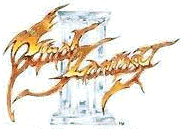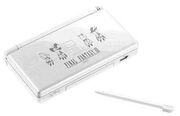| Строка 62: | Строка 62: | ||
Игровой процесс содержит элементы первых двух игр ''Final Fantasy'', а также вводит некоторые новые. В игру возвращается система [[Очки Опыта|очков опыта]] из оригинальной ''[[Final Fantasy]]'', которая отсутствовала в ''[[Final Fantasy II]]''. В ''Final Fantasy III'' введена новая система игровых классов - в отличие от первой ''Final Fantasy'', где игрок должен был выбирать игровые классы в самом начале игры, и ''Final Fantasy II'', в которой классов как таковых не было, ''Final Fantasy III'' вводит [[Система Классов|систему игровых классов-профессий]], благодаря которой вся серия игр стала широко известной. |
Игровой процесс содержит элементы первых двух игр ''Final Fantasy'', а также вводит некоторые новые. В игру возвращается система [[Очки Опыта|очков опыта]] из оригинальной ''[[Final Fantasy]]'', которая отсутствовала в ''[[Final Fantasy II]]''. В ''Final Fantasy III'' введена новая система игровых классов - в отличие от первой ''Final Fantasy'', где игрок должен был выбирать игровые классы в самом начале игры, и ''Final Fantasy II'', в которой классов как таковых не было, ''Final Fantasy III'' вводит [[Система Классов|систему игровых классов-профессий]], благодаря которой вся серия игр стала широко известной. |
||
| − | С учетом четырех персонажей, формирующих группу, и 23 игровых классов, существует 279841 различных конфигураций группы. Игровые классы обладают свойством взаимозаменяемости: все четыре персонажа - [[Воины Света]] - начинают игру с классом либо "[[Луковый Рыцарь (Final Fantasy III)|Луковый Рыцарь]]" (в версии для Famicom) или "[[Фрилансер (Final Fantasy III)|Фрилансер]]" (в версиях для DS и iOS), а впоследствии имеют возможность сменить свой класс на любой другой |
+ | С учетом четырех персонажей, формирующих группу, и 23 игровых классов, существует 279841 различных конфигураций группы. Игровые классы обладают свойством взаимозаменяемости: все четыре персонажа - [[Воины Света]] - начинают игру с классом либо "[[Луковый Рыцарь (Final Fantasy III)|Луковый Рыцарь]]" (в версии для Famicom) или "[[Фрилансер (Final Fantasy III)|Фрилансер]]" (в версиях для DS и iOS), а впоследствии имеют возможность сменить свой класс на любой другой. При этом, чем больше [[Кристалл (термин)#Final Fantasy III|Кристаллов]] они находят и дополнительных задач выполняют, тем больше классов становится доступно. В игре ''Final Fantasy III'' представлены следующие игровые классы: |
{|width="100%" |
{|width="100%" |
||
Версия от 07:20, 11 мая 2012
| Перед вами незавершенная статья. Она содержит неполную информацию по данной теме. Для улучшения статьи требуется: не указано. Вы можете помочь Final Fantasy Wiki, если дополните её. |
Шаблон:IncompleteTable Это статья об игре для NES и ее римейка на Nintendo DS. Статья об игре на SNES, выпущенной под таким названием в США — Final Fantasy VI. Шаблон:Infobox CVG
- “Таково пророчество Гулгана: 'Землетрясение было только началом...'”
- — Заставка Final Fantasy III в версии для Nintendo DS
Final Fantasy III - третья игра из серии игр Final Fantasy, разработанная компанией Square Co., Ltd. и выпущенная для игровой консоли Nintendo Family Computer (Famicom). За пределами Японии игра была вепрвые официально выпущена только вместе с ее римейком для карманной консоли Nintendo DS.
Вплоть до 2006 года Final Fantasy III была единственно игрой в серии, никогда не имевшей англоязычной локализации и не выпускавшейся за пределами Японии. Она также была единственной игрой из ранних игр серии, не имевшей переизданий на других платформах или римейков. Некоторое время существовал план по выпуску игры на консоли WonderSwan Color компании Bandai, однако разработчики столкнулись с трудностями при конвертировании игрового картриджа оригинальной игры для Famicom на WonderSwan Color, что привело к многочисленным задержкам, а впоследствии этот проект и вовсе был закрыт из-за отмены выпуска консоли. Впервые улучшенный римейк игры для Nintendo DS вышел в 2006 году в Японии и США, а в 2007 - и в других странах. В 2011 году на платформе iOS было выпущено переиздание версии для DS с улучшенной графикой.
Музыкальное сопровождение к игре Final Fantasy III было создано Нобуо Уэмацу, для которого это 21-й опыт создания музыки для видеоигр.
Геймплей
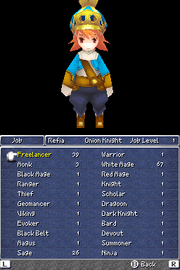
Выбор игрового класса в версии для DS.
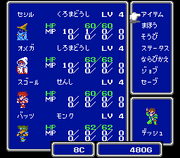
Экран главного меню в версии для Famicom.
Игровой процесс содержит элементы первых двух игр Final Fantasy, а также вводит некоторые новые. В игру возвращается система очков опыта из оригинальной Final Fantasy, которая отсутствовала в Final Fantasy II. В Final Fantasy III введена новая система игровых классов - в отличие от первой Final Fantasy, где игрок должен был выбирать игровые классы в самом начале игры, и Final Fantasy II, в которой классов как таковых не было, Final Fantasy III вводит систему игровых классов-профессий, благодаря которой вся серия игр стала широко известной.
С учетом четырех персонажей, формирующих группу, и 23 игровых классов, существует 279841 различных конфигураций группы. Игровые классы обладают свойством взаимозаменяемости: все четыре персонажа - Воины Света - начинают игру с классом либо "Луковый Рыцарь" (в версии для Famicom) или "Фрилансер" (в версиях для DS и iOS), а впоследствии имеют возможность сменить свой класс на любой другой. При этом, чем больше Кристаллов они находят и дополнительных задач выполняют, тем больше классов становится доступно. В игре Final Fantasy III представлены следующие игровые классы:
|
|
Final Fantasy III также является первой игрой в серии, в которой введены дополнительные боевые команды кроме Магии - например, Кража или Прыжок, при этом каждая такая команда связана с определенным классом. Также именно в этой игре впервые в серии появляются призываемые существа.
Персонажи
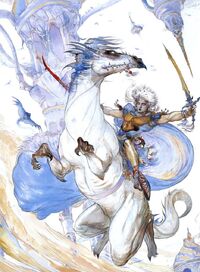
Безымянный воин, рисунок Ёситака Амано.
В оригинальной версии игры для Famicom игрок управлял четырьмя безымянными Воинами Света. Это четверо подростков без отличительных черт и особенностей личности, которым по нахождении ими Кристалла Ветра последний даровал силу и мощь для спасения мира. Хотя их пол нигде явно не указывается, предполагается, что все они мальчики. Во время их путешествия к ним присоединяются различные вспомогательные персонажи, бесполезные в бою, но помогающие на Карте Мира.
В версии для DS/iOS четверка протагонистов получила имена и личности, отличные от показанных в официальной манге. В римейках также рассказываются их новые предыстории, делающие сюжет более динамичным. Главным героем здесь является Люнет, отправляющийся в поход со своим лучшим другом Арком после того, как получил задание спасти все четыре кристалла мира. Спустя короткое время после начала событий они встречают дочь кузнеца Рефию и рыцаря Замка Сасунэ Ингуса. В игре все также появляются вспомогательные персонажи, вроде Сида или Сары, но, присоединившись к группе, они помогают героям уже в бою, атакуя монстров в соответствии со своими умениями либо излечивая остальных членов группы.
В оригинальной версии игры ни один из Луковых Рыцарей не имел имени, однако в официальной манге Yuukyuu no Kaze Densetsu: Final Fantasy III Yori, выпущенной по сюжету игры, им были даны следующие имена: Муучи (англ. Muuchi, яп. ムウチ?), Даг (англ. Doug, яп. ダグ?), Дж. Боуи (англ. J. Bowie, яп. J・ボウイ?) и Мэлфи (англ. Melfi, яп. メルフィ?) (последняя героиня является единственной девочкой в группе). На скриншотах оригинальной игры в руководстве Dissidia Ultimania Луковые Рыцари названы именами героев из римейка для Nintendo DS.
Both versions of the game's logo, and several of Yoshitaka Amano's artwork, show a white-haired, muscular warrior. This character is never named and never appears in the game. His design is strikingly similar to later Amano drawings of the protagonist of Final Fantasy V, Bartz Klauser. His ponytail and longsword are also similar to that of Desch's character in the DS version of Final Fantasy III. His general appearance greatly resembles Luneth. Many assume the unnamed warrior is the basis for Luneth's design.
Сюжет
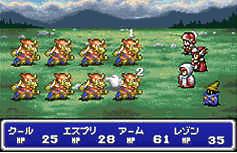
Screenshot of the aborted WonderSwan Color port.
Many years ago, on a Floating Continent hovering high above the surface of an unnamed planet, a technologically advanced civilization sought to harness the power of the four elemental crystals of light. They did not realize they could not hope to control such fundamental forces of nature. This power of light would have consumed the world itself had the light crystals not had their natural counterparts: the four dark elemental crystals. Disturbed by the interruption of the careful balance of the light and the dark, four warriors were granted the power of the dark crystals in order to re-contain the light crystals' power.
These so-called Dark Warriors succeeded in their quest, and restored harmony to the world. But their victory came too late to save the doomed civilization that had foolishly tried to harness the crystals' power. Their once-proud culture was reduced to ruin, though their floating continent remained, a reminder of what had come before. And on that very continent, the circle of Gulgans, a race of blind soothsayers and fortune-tellers, predicted things to eventually come full circle. Just as the power of light can be abused, so, too, can the power of darkness. And when that would occur, the crystals of the light would call forth their own champions to restore balance to the world.
One day, an earthquake opens up a previously hidden cavern in Altar Cave near the village of Ur on the floating continent. Four orphaned youths under the care of Topapa, the village elder, go exploring and come across a crystal of light: the Crystal of Wind. The crystal grants them a portion of its power and their first several Jobs, and instructs them to go forth and restore balance to the world. Not knowing what to make of the crystal's pronouncements, but nonetheless recognizing the importance of its words, the four inform their adoptive family of their mission and set out to explore.
In the DS version, only Luneth falls down and discovers the Crystal of Wind, and is not initially granted its power. After receiving his task, he goes to find his friend Arc, who is being picked on by the other kids of the village. Together they journey to Kazus, the village cursed by the Djinn. They seek out Refia, and all three journey to Castle Sasune to see the King and retrieve the Mythril Ring. They are granted access by the royal guard Ingus, who becomes their fourth companion.
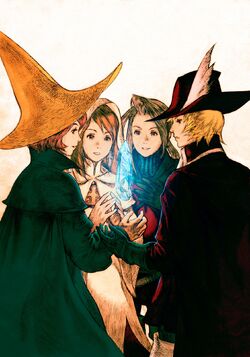
The Four DS Warriors of Light; (From left to right) Arc, Refia, Luneth, and Ingus. Artwork by Akihiko Yoshida.
The four journey back to Kazus and enter the Sealed Cave. There they find Princess Sara, who has the ring, and with her help, they are able to defeat the Djinn. She returns to the castle while they are transported to the Altar Cave, where lies the Wind Crystal. It bestows upon them its light and several Jobs, and officially makes them the Warriors of Light. They are instructed to restore the other crystals and bring equilibrium back to the world.
Back at Castle Sasune, Princess Sara uses the Mythril Ring to break the curse and free the people. The warriors say farewell, Ingus promising to return to visit Sara, and then go and find Cid in Kazus. He uses his airship to aid them in ramming the boulder that blocks their way. Unfortunately it comes at the cost of the airship, rendering the party land bound. In order to fulfill their destiny they must find King Argus, however, they must first find a ship.
In the mean time, they journey to the town of Canaan and meet Cid's wife and a strange girl named Salina. She mourns the disappearance of her love, Desch. The four, hearing that he bought the last Mini spell they were searching for, journey to Dragon's Peak where he was last seen. After scaling the peak, they encounter and are kidnapped by Bahamut, who drops them off at its nest where they encounter the mysterious Desch. They learn he has lost his memory, and so he decides to join them in hopes of regaining it.
Using Desch's Mini spell, the group heads for Tozus, the hidden village of the gnomes. The main purpose in traveling there is to pass through Tozus Tunnel, beneath the Myranos Mountains, and reach Vikings' Cove, where they may acquire a ship. They find the Vikings in an uproar as their feared water deity, the Nepto Dragon, has become wild and angry. The Viking Chief requests the warriors' aid.
They journey to the Nepto Temple where they find an idol of the Nepto Dragon is missing an eye jewel. They shrink down in order to work their way through the tunnels inside the Temple walls, and fight enemies along the way. Eventually they find the missing eye in the horde of a rat, and after defeating it, the four take the eye. They return the eye to the socket and appease the angry Nepto Dragon. In gratitude, the Vikings bestow upon the heroes the good ship Enterprise.
Sailing upon the Enterprise, the heroes explore the continent. They travel to the Village of the Ancients, and learn the continent they are on is actually floating above the old world. They eventually find the Tower of Owen, and battle through the tower hearing taunts from a mysterious person every now and again. When they reach the main room, they find Medusa, servant of Xande, waiting for them. After defeating her, Desch's memory returns. He recalls he is one of the ancients who was the Guardian of the Tower. He also tells the warriors the tower is the force keeping the floating continent floating. As it threatens to fall, Desch leaps into the central furnace and the tower soon stops shaking and the four leave.
They head for Dwarven Hollows in search of the Fire Crystal. The dwarves are preoccupied because one of their precious ice horns was stolen by Gutsco the Rogue. They follow him into the subterranean lake, making use of the Toad spell. After "defeating" him, they make their way back up to Dwarven Hallows, followed by a mysterious shadow. When they reach the main altar, Gutsco reveals himself and grabs both horns.
The four pursue him again, this time into the Molten Cave. Gutsco leads them straight to the Crystal of Fire, whose power he absorbs. He turns into a dragon and the battle ensues. After defeating Gutsco a second time, they receive the light of the Fire Crystal and several additional Jobs, and return the Horns of Ice.
With their new Jobs and abilities, the Warriors of Light sail to Tokkul, a village left in shambles, where they learn the evil Hein, adviser to King Argus, has captured the King, enslaved the people, and uprooted the Elder Tree from the Living Woods. They are attacked and kidnapped by Hein's men, and taken to Castle Hein, which is actually the floating Elder Tree.

Final Fantasy III Warriors of Light.
The Warriors of Light defeat the evil sorcerer and restore the Elder Tree. Upon reaching Castle Argus, King Argus welcomes them and thanks them for their deeds. They receive the Wheel of Time from the King, and finally take it back to Cid who changes their ship into an airship and tells them the truth. The four of them are not from the floating continent, but from the world below. They were traveling with Cid when they were very young, and ran into a mysterious cloud. The ship crashed and Cid never saw them again. Made even more curious by the news, the four travel back to the world below and find that their "continent" is nothing but a small island on the face of a huge world.
The overworld is a swirling mess of darkness with a few large landmasses visible here and there. They fly the Enterprise to a wrecked ship and find an old man tending to a young girl inside. They aid her with a Potion and immediately she recovers. She recognizes them as the Warriors of Light and asks if the world is no longer frozen. Hearing it is not restored, Aria, the girl, journeys with the warriors to the Temple of Water and recovers the shard of the Water Crystal. Using the shard, she opens the way to the Cave of Tides.
She reveals she is one of the last Priestesses of Water. They make their way to the crystal, and Aria returns the shard. As she steps from the altar, she instructs the Warriors to return the light to the crystal. As they approach, Aria suddenly pushes Luneth out of the way of a blast of magic. She falls, and Kraken reveals himself. The four battle him, and once he falls, light is restored to the crystal and the world is returned to normal, as Aria slowly dies.
In the new world, the four awaken in the Town of Amur. They find their ship tied with a chain, and so journey to Goldor's Mansion to retrieve the key and the fourth crystal. Goldor shatters the crystal, but drops the key. They return to Amur and free the Enterprise.
They fly around, visiting several towns, but are shot down over the Megalopolis of Saronia. They find the kingdom in uproar over the decrees of the seemingly mad king. The army has been divided against itself and shops everywhere have been closed. They find the King's son, Prince Alus, in south-west Saronia, who has been banished from the castle by his own father. Arc convinces the rest to aid him. Strangely, they are permitted to enter the castle upon their return, but later that night, Alus wakes up to find his father standing over his bed with a knife. His father plunges the knife into his own stomach and is free from the spell placed upon him by Garuda. They fight and kill Garuda, and Prince Alus becomes the new king.
Shortly afterward, scholars inform the party the airship Nautilus. has been unearthed. Using it, the party journeys the perilous skies to the Dalg Continent where they meet Doga and his moogle bodyguards in Doga's Mansion. He joins their party and uses Mini on them to enter The Cave of the Circle. When they reach the end of the cave, Doga uses a spell to make the Nautilus capable of safe underwater travel, making it a submarine in addition to an airship. He tells The Warriors of Light to go to the Temple of Time and recover Noah's Lute, which would awaken Unei, the guardian of the dream realm, from her eternal slumber. He then leaves the warriors, asking them to give Unei his regards.
Doing as Doga had asked of them, the Light Warriors use Noah's Lute to awaken Unei. She happily joins the party and together they go to the Ancient Ruins and manage to take control of a large airship called the Invincible. After telling the Warriors of Light of its many uses, she bids them farewell.
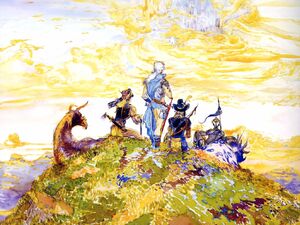
Amano's version of the Warriors of the Light.
When the party travels to the Cave of Shadows, they find the Fang of Earth, and they head back to Doga's Manor to visit Doga and Unei. Upon entering Doga's manor, they are teleported to a cave, in which Doga and Unei are waiting. They tell the Warriors of Light to defeat them in battle. Reluctantly, they do as they are told, and are explained why they were needed to be killed. As it turns out, Doga and Unei's souls were needed to power the keys needed to open the forbidden land of Eureka and Crystal Tower.
Before entering the Crystal Tower, they go through the Maze of the Ancients, which is where the final crystal is held. After receiving said crystal, the warriors travel through the Crystal Tower and attempt to cross over to the Dark World. Before crossing, they find themselves under the curse of the Five Wyrms, which holds the party locked in place. Doga remedies this by finding five past allies of the warriors to break the curse. The five allies are Princess Sara, Cid, Desch (who did not die upon hurling himself into the tower), King Alus, and one of the four old men from Amur. After breaking the curse the allies wish the Light Warriors the best of luck, the heroes reach the portal to the World of Darkness.
In front of the black vortex, the warriors confront Xande and defeat him. After he dies, they face the Cloud of Darkness, who was manipulating Xande without his knowledge to reduce the world to nothingness. They fail to defeat their enemy and are killed by her particle beam. Fortunately, with the light of the five allies who had helped them before, they are revived and continue into the World of Darkness. Within, they defeat four malevolent beings, who are guarding the crystals' dark counterparts. The crystals reveal the four Warriors of the Dark, who stopped the light from engulfing their world many years ago.
When they all face the Cloud of Darkness again, the four Warriors of the Dark sacrifice themselves so that the Warriors of Light are able to defeat their adversary. With one last battle, the Cloud of Darkness is defeated, and the heroes and their allies return to their homes. The old man returns to Amur, Alus returns to his kingdom, and Cid and Desch return home to their lovers. Sara, on the other hand, does not want to leave Ingus, and stays with him a while longer. Each of the heroes end up going their own ways, with Ingus and Sara returning to Castle Sasune, Refia taking up blacksmithing in Kazus, and Luneth and Arc returning to Ur. This conflicts slightly with the Famicom version, in which all of the main characters returned to Ur together.
Разработка
Final Fantasy III is visually similar and uses a similar graphic system as Final Fantasy and Final Fantasy II. Final Fantasy III expands the gameplay dramatically with its introduction of the changeable Job system. Another major addition is that Final Fantasy III is the first game in the series to feature auto-targeting; in the previous titles a character attacking an enemy that was killed by a previous attack, would simply attack nothing, and a message would read "ineffective".
The Famicom version also eliminates the previous games' text heavy battle presentation. In the previous titles, attacks, spell names, damage registered, number of hits, and other info is displayed in cascading windows at the bottom of the screen. Final Fantasy III, however, replaces this with damage being displayed on the enemy sprite after the attack.
One notable stylistic change is that the background of all windows and menus is changed from black to blue, something that would become a staple. Another major gameplay enhancement is that Final Fantasy III is the first title in the series to feature characters who have unique action commands in battle, such as Summon, Throw, and Jump.
Переиздания и римейки
Версия для Nintendo DS
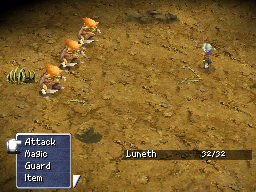
The first battle of Final Fantasy III in the Nintendo DS remake.
The Final Fantasy III Nintendo DS remake was first revealed to be in development on October 7, 2004, but detailed information did not emerge until a year later. Hiromichi Tanaka, one of the original game's main designers, was the head of the project as both the executive producer and director. His guidance and supervision was needed because the game was not meant to be a mere graphics update like the updates for Final Fantasy I & II: Dawn of Souls, but a total overhaul using the Nintendo DS's 3D capabilities, even though the layout of most dungeons and towns would remain identical to the original. Ryosuke Aiba, the art director of Final Fantasy XI, was hired as the new art director.
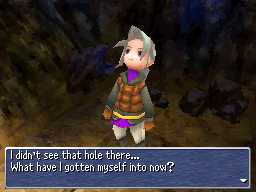
An early official screenshot of Luneth in the English version of the remake.
Akihiko Yoshida was hired to revamp the original character designs. The main characters were given backstories, personalities and default names: Luneth (Runesu), Arc (Arukuu), Refia (Refia), and Ingus (Inguzu). Even though the characters were given background and development, it does not change the main storyline.
Overhauls were made to the Job system, including the re-balancing of the classes, the addition of new abilities, the removal of Capacity Points, and a new "Bare" ("Freelancer" in the US version) class as the new default Job class with the Onion Knight becoming a separate class. Unlike the original Famicom version, most of the Jobs remain useful for the entire game; the ultimate Jobs, the Ninja and the Sage, are rebalanced to stay on the same level as the others.
Finally, the game makes use of the DS's WiFi capabilities through an e-mail system known as "MogNet", in a nod to Final Fantasy IX's similar system, for players to exchange messages to each other through WiFi communications. Besides being a way to share thoughts, using Mognet can also be used to unlock and complete sidequests, as well as just send mail to the NPCs met on the way.
The DS remake of Final Fantasy III was released in the United States on November 14, 2006. The game was released in Europe on May 4, 2007. One of the biggest criticisms of the game was that the battles are remarkably different - the size of a DS game at the time imposed restrictions, and there are less enemies on the screen at any given fight. In addition to the overhauls in the job system, the enemies are made stronger to compensate for their decreased numbers. As such, quite a bit more Level Grinding is necessary even for boss monsters, which attack more frequently. By the release of the subsequent remake, Final Fantasy IV, the increased ROM size allowed the developers to retain the original number of enemies in a group.
Специальное издание Nintendo DS
On the same day Final Fantasy III was released, Square Enix began selling the bundle package with the game and a special Crystal White DS Lite. The DS has Akihiko Yoshida's artwork on the top of the system. The DS Lite was released in Japan only, and is shown with the Final Fantasy III logo and a few of the main characters emblazoned on the front.
Версия для iOS
Final Fantasy III was released for iOS 3.0+ devices on March 24, 2011, and is available for purchase exclusively via the Apple App Store. It is an enhanced port of the DS release, with the same characters and general design, but higher quality graphics and sound.
The original DS version runs at 256x192 on each display. The resolution for iOS release runs at either 480x320 or "Retina" display 960x640 native resolutions. The latter resolution is supported only on devices with the 960x640 "Retina" displays (iPhone 4, 4S, and iPod Touch 4th Generation). On the iPad, it is natively run at 1024x768. Graphical enhancements for the iPad had came out one month after with the release of an update on April 21, 2011.
The release on iOS includes minor dialogue changes, such as the NPC explaining features and controls unique to iOS devices. The player controls the character actions via touch input since there are no physical buttons to use. For example, the ability to zoom in the camera with the L button in the Nintendo DS version is done by using a two finger pinch gesture. The character movement is done by using an on-screen analog stick. The subtitle/dialogues font was changed for some arial-like, more big and separated, easing the lecture.
Since the iPad, iPhone, and iPod Touch do not have two physical screens, iOS release forgoes what is displayed on the screen seen in the DS version, but allows access to various functions through menus the player can access by touching buttons overlaid on the screen.
There is no internet-enabled functionality like its Nintendo DS counterpart, which uses the Nintendo WiFi Connection for Mognet to unlock a secret Job class. It is unknown if the iOS version will gain internet functionality through Apple's Game Center (equivalent to Nintendo WiFi Connection) in a future update. Instead, the quest to acquire the Onion Knight can be completed after the events of the Fire Crystal.
In the iOS version, it is possible to skip monsters by pressing the Home button during the battle. When the person enters the app again, it will show the character as was right before the encounter if the player selects the Quicksave option. This happens because the game quicksaves before a battle and after a battle. However, this can cause a player to be severely underleveled, and bosses will be much harder.
Спрятанные подарки от разработчиков (Easter Eggs)
- In the Famicom release, a little girl, hidden in an east room in the town of Gysahl, encourages the player to write inquiries to Square, listing out the mailing address.
- In Ur and Amur, there are pianos Luneth and friends can play.
Создатели игры
Оригинальня версия для Famicom
- Director - Хиронобу Сакагути
- Producer - Masafumi Miyamoto
- Co-designers - Hiromichi Tanaka, Kazuhiko Aoki, Koichi Ishii
- Programmer - Nasir Gebelli, Kiyoshi Yoshii, Katsuhisa Higuchi
- Character Designer, Title Logo Designer, and Graphic Designer - Ёситака Амано
- Co-writer - Kenji Terada
- Composer - Нобуо Уэмацу
| Этот раздел статьи является заготовкой. Вы можете помочь Final Fantasy Wiki, дополнив или расширив его. |
Обложки
Шаблон:Галерея
Интересные факты
- In the DS version, there is a contradiction towards the story of how the four children came to be. According to Cid, the children were not originally from this world, stating that ten years prior to the game, he was ferrying people to and from the continents when an unknown evil struck, causing his ship to be destroyed. This contradicts what Unei says: that the Surface World had been closed off for a thousand years. However, this could be due to a time anomaly caused when the Surface World was engulfed in darkness; for all Cid knows, he could have been drifting aimlessly, frozen in time, for a thousand years, directly near the Floating Continent, and the power of the crystals may have allowed his airship to drift into the Floating Continent, freeing him from being frozen in time.
- In 1999, Final Fantasy III was unofficially translated into English by Neill Corlett and Alex W. Jackson. In addition to this popular fan-translation, there exists an alternate complete one.
- In the DS/iOS Version, upwards of 9999 damage can be dealt by every character, and although the game will only show 9999, it calculates according to the actual amount.
- Final Fantasy III was the first appearance of moogles and the fat chocobo in the series.
- The "circumnavigate the world on a Chocobo for reward" quest originates in Final Fantasy III, to be repeated in Final Fantasy V.
- Final Fantasy III was the first game in the series to graphically show hit points when a target is attacked or healed, rather than use caption as in the original versions of the previous two games. It is also the first to contain auto-targeting, as well as the first to contain special battle music for boss battles. All of these aspects were adapted in the remakes of the previous two games.
- The names of Doga and Unei, two key characters in Final Fantasy III, appear in multiple Final Fantasy games, including Final Fantasy IX, which contains a sub-quest involving two items named "Doga's Artifact" and "Une's Mirror". These items unlock a hidden theme titled "Doga and Une" in the Black Mage Village.
- Several of the game's songs were used in Chocobo Racing, including the opening theme ("Crystal Cave") and the final battle theme.
- Though most of the sprites for 8-Bit Theater are from the original Final Fantasy, many other sprites, including the new class changed Light Warriors, are game sprites from the Famicom Final Fantasy III.
- The original background music for the town of Amur was used in creating the song "Cloud Smiles" in Final Fantasy VII: Advent Children.
- In the original idea of the DS version Luneth, Arc, Refia, and Ingus were adopted children of Topapa, but this was changed to make the four separate characters have their own stories.
- In Final Fantasy 20th Anniversary and the Final Fantasy portion of Final Fantasy I & II: Dawn of Souls, the Two Headed Dragon, Echidna, Cerberus, and Ahriman appear as bosses in the optional Earthgift Shrine, with the "Battle 2" as BGM. In Final Fantasy IV: The After Years, they return as guardians for the crystals of the True Moon.
- Final Fantasy III is the only game in the main series to never appear on a Sony platform, although it should be noted Square Enix did consider porting the game to the PlayStation 2, but was eventually convinced by Nintendo to develop the title for their new handheld system, the Nintendo DS.
Внешние ссылки
- Final Fantasy III DS official site (Japanese)
- Final Fantasy III DS official site (North American)

